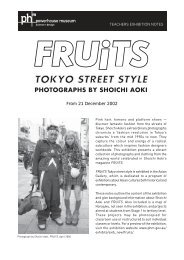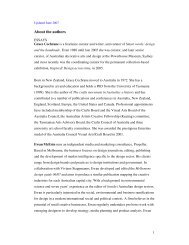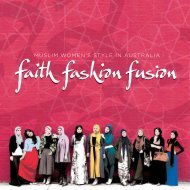design across time - Powerhouse Museum
design across time - Powerhouse Museum
design across time - Powerhouse Museum
You also want an ePaper? Increase the reach of your titles
YUMPU automatically turns print PDFs into web optimized ePapers that Google loves.
+ 19 powerline spring 05<br />
THE CUTTING EDGE: FASHION FROM JAPAN GIVES<br />
INSIGHT INTO THE POWER OF JAPANESE FASHION<br />
AND WHY IT CONTINUES TO LEAD THE WAY.<br />
story_LOUISE MITCHELL, CURATOR, INTERNATIONAL DECORATIVE ARTS AND DESIGN<br />
the cutting edge<br />
Radical and conceptual, challenging and<br />
uncompromising, functional and some<strong>time</strong>s<br />
incomprehensible, fashion from Japan has<br />
commanded international attention since the 1970s<br />
and ’80s. Now a new generation of <strong>design</strong>ers<br />
continues to lead the way using technologically<br />
advanced fabrics and technical ingenuity.<br />
The pioneers of Japanese fashion were Hanae Mori,<br />
the first Japanese <strong>design</strong>er to show abroad, in New<br />
York in 1965; the <strong>design</strong>er known as Kenzo; and Issey<br />
Miyake, whose name is perhaps the most well known<br />
in the west. After establishing the Miyake Design<br />
Studio in Tokyo in 1970, Miyake showed his first<br />
collection in New York in 1971, and in Paris in 1973.<br />
Along with his interest in utilising aspects of<br />
Japanese folk culture and traditional textiles, Miyake’s<br />
preoccupation during the ’70s was the development<br />
of fashion reduced to its simplest elements. Drawing<br />
on the tradition of the kimono he produced garments<br />
which were, essentially, square or rectangular pieces<br />
of cloth, with sleeves attached, that could be<br />
wrapped and draped around the body.<br />
Over the years, Miyake has collaborated with<br />
weavers, artists, poets, choreographers and<br />
photographers as part of his exploration of what<br />
clothes can do and be made from. While these<br />
stunning sculptural creations were more at home in a<br />
museum or art gallery, his innovative pleated clothes,<br />
developed in the 1990s, reflect his continuing aim to<br />
create practical, modern clothes that are beyond<br />
trends. Similarly, his current preoccupation A-POC (a<br />
piece of cloth), a long tube of stretch fabric that<br />
doesn’t require any sewing and is cut by the<br />
customer without wasting any material, shows an<br />
ongoing commitment to progressive <strong>design</strong>.<br />
Miyake was the first of the Japanese avant-garde to<br />
gain an international reputation, but it was the impact<br />
of Rei Kawakubo and Yohji Yamamoto’s collaborative<br />
catwalk shows in the early 1980s that really created<br />
an intense awareness of Japanese fashion.<br />
Kawakubo and Yamamoto’s garments were<br />
characterised by intentional flaws, a monochrome<br />
palette, exaggerated proportions, drapery, asymmetry<br />
and gender-neutral styling. The clothes and models<br />
looked shabby in contrast to the power suits and<br />
fantasy evening dresses in vogue at the <strong>time</strong>.<br />
Although the clothes by these two <strong>design</strong>ers were<br />
just as groundbreaking in Japan, it has been argued<br />
that the aesthetics of traditional Japanese culture,<br />
particularly of wabi sabi (beauty that is imperfect,<br />
impermanent or incomplete), and of the kimono were<br />
inherent within their work. Initially the response to<br />
these Japanese <strong>design</strong>s was hostile but within a few<br />
years the new aesthetic came to have a major<br />
influence on mainstream fashion.<br />
Rei Kawakubo had already established her<br />
commercially successful clothing label ‘Comme des<br />
Garçons’ (Like some boys) in Japan before she<br />
teamed up with Yohji Yamamo to present her<br />
controversial collections in Paris in the early 1980s.<br />
Kawakubo’s often-quoted remark, ‘I work with three<br />
shades of black’, belies the fact that since the mid<br />
1980s she has departed from her original sombre<br />
palette and her collections throughout the 1990s and<br />
early this century have often incorporated bright<br />
colours. Over the years her clothes have ranged from<br />
sombre, asymmetrical and loose fitting to colourful,<br />
light-hearted, romantic and structured. While her<br />
<strong>design</strong>s have changed a lot and her collections are<br />
unpredictable, in Kawakubo’s attempts to defy<br />
conventional beauty, her clothes are still inclined to<br />
offend Western assumptions of taste and tradition.<br />
Her stated aim is to avoid conformity and to do<br />
something new each <strong>time</strong> she creates a collection.<br />
Since parting ways with Kawakubo, Yohji Yamamoto’s<br />
collections have been characterised by romanticism<br />
more in tune with Western aesthetics. He is renowned<br />
for working mostly with black and white and his<br />
clothes often have a sculptural quality. Yamamoto<br />
likes to combine unusual materials with a<br />
recognisable silhouette — for example, an evening<br />
dress made from a felt similar to that used for billiard<br />
tables. His clothes are marked by historical<br />
references and a sense of renewal, seen in his<br />
blending of culture and history.<br />
Now in their 60s, Miyake, Kawakubo and Yamamoto<br />
are based in Tokyo where they head large,<br />
commercially successful companies that produce<br />
clothing lines for the local market, as well as<br />
participating in Paris at the twice-yearly prêt-à-porter<br />
collections. Their creative dominance remains<br />
unchallenged and the new generation of <strong>design</strong>ers<br />
have often begun their careers working for them.<br />
Junya Watanabe and Jun Takahashi, for example,<br />
have been protégés of Kawakubo, while Kosuke<br />
Tsumura and Hiroaki Ohya have developed their own<br />
labels within the Miyake group of companies.<br />
Junya Watanabe is the most celebrated of the<br />
younger generation of Japanese <strong>design</strong>ers. Like his<br />
mentor, Watanabe is interested in innovative textiles<br />
and construction techniques, describing his <strong>design</strong>s<br />
as ‘techno couture’. The first collection to bring him<br />
international acclaim was in 1995 when he showed<br />
slim-lined knee-length tunics and pantsuits made<br />
from a polyurethane laminated nylon in bright colours<br />
inspired by the cellophane used in theatre lighting.<br />
Although the garments have simple silhouettes, the<br />
construction is visibly complex with folds, tucks and<br />
pleats emphasised at the joins of the body to make<br />
the outfits more comfortable.<br />
Jun Takahashi began his <strong>design</strong> career as a cult<br />
figure in Tokyo’s Harajyuku, the centre of Japanese<br />
fashion subculture. In 2000, under the aegis of Rei<br />
Kawakubo, he debuted his ‘Undercover’ label in Paris<br />
to much acclaim. Detail, layering and eclectic use of<br />
colour and pattern are characteristic of Takahashi’s<br />
work, which he describes as lying somewhere<br />
between high fashion and street wear.<br />
Hiroaki Ohya cites Issey Miyake as the <strong>design</strong>er who<br />
has had the greatest influence on him. An example of<br />
this aim ‘to always seek or create something new’ is<br />
his work ‘The Wizard of Jeanz’, a remarkable series of<br />
21 cloth ‘books’ that fold out into clothes. Drawing<br />
both on origami, the Japanese art of paper folding,<br />
and the book The Wizard of Oz, ‘The Wizard of Jeanz’<br />
is a technical tour de force that allows a book to<br />
transform into a ruffled neckpiece, a pair of jeans or<br />
an elegant evening dress<br />
Like Ohya, Kosuke Tsumura questions the role of<br />
fashion in today’s society. Since 1994 the signature<br />
piece for his label ‘Final Home’ has been a<br />
transparent nylon coat with up to 40 multifunction zip<br />
pockets, conceived as a final home in the case of<br />
natural or man-made disaster. Tsumura was<br />
motivated to rethink his attitude to fashion by the<br />
growing number of homeless living in Tokyo. The<br />
combination of the simplicity of Tsumura’s <strong>design</strong>s,<br />
coupled with their humorous functionality has made<br />
‘Final Home’ a top label in Japan among the young.<br />
The cutting edge: fashion from Japan opens on 27<br />
September.<br />
Presented by the <strong>Powerhouse</strong> <strong>Museum</strong> in association with the Kyoto<br />
Costume Institute. Media partners: marie claire & SBS Radio. Supporter:<br />
Japan Foundation. Catalogue sponsors: The Gordon Darling Foundation &<br />
The Suntory Foundation.<br />
WORKS FROM FOUR OF THE 19 DESIGNERS FEATURED IN THE CUTTING EDGE (CLOCKWISE FROM TOP LEFT): POLYESTER ORGANDIE NECK RUFF, JUNYA WATANABE, 2000/01. PHOTO BY TAISHI HIROKAWA, COURTESY KYOTO<br />
COSTUME INSTITUTE; FELT DRESS, YOHJI YAMAMOTO, 1996.. PHOTO BY TAKASHI HATAKEYAMA, COURTESY KYOTO COSTUME INSTITUTE; DETAIL OF DRESS, JUN TAKAHASHI, 2005. PHOTO BY MARINCO KOJDANOVSKI; FROM ‘THE<br />
WIZARD OF JEANZ’ SERIES, HIROAKI OHYA, 2000. PHOTO BY MARINCO KOJDANOVSKI.
















